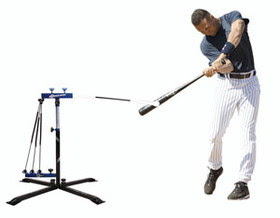
BaseballDealz Ebay Store
Recognizing a curve ball quickly is not an easy thing to do. Hitting a well located curve is not easy either.That's why you will hear the expression, "he's a good fastball hitter" ten times for every one time you will hear, "he's a good curve ball hitter." I'm well aware that part of that is because there are many more fastballs being thrown, so of course more fastballs will be hit harder. But I'm also well aware that the movement on the curve makes baseball hitting much more difficult and the slower speed disrupts timing. The quicker you can recognize that it's the curve that the pitcher is throwing, the better chance you will have of hitting it well. Like we've said many times, a fraction of a second is an eternity when it comes to baseball hitting and it most certainly applies here. That's why pitchers who have "late breaking" pitches are usually very successful, because the batter does not realize it is a breaking ball until it's a fraction of a second too late.
Ways to Recognize the Curve Ball Quickly:
Watch the release point of the pitcher very closely. The pitcher's release point may be slightly different from the fastball point of release.
Watch the trajectory of the ball as soon as it's released by the pitcher. It could very well have a slight arc to it that is not present on the fast ball.
Watch the pitcher's arm angle. There's a strong possibility that with the fastball, the pitcher may come almost directly overhand and with the curve he may drop down a little bit. This happens very often.
Practice watching as many curve balls as possible.
Let's say you play three times a week and get about ten at bats per week. Out of those ten at bats, you see about one curve per at bat, which is about ten per week. I strongly suggest that to improve at recognizing a curve quicker, you must see more than ten per week. If you are serious about baseball hitting and having better at bats against the curve ball, here is what I highly recommend you do.
Whenever you have batting practice with your team, ask your pitcher to mix in some curve balls during your last ten or twelve swings.
If one of your pitchers is pitching batting practice, stand behind the backstop and practice trying to recognize his curve ball as quickly as possible.
If one of your pitchers is throwing a "bull pen," go stand nearby and watch him closely. Try to read the curve as quickly as you can. (If you're serious about your baseball hitting, you will find the time to do these things.)
By doing the things listed above, you may very well be seeing 50 curve balls per week instead of only 10 per week. I'm well aware that it's not as efficient as if you were up there hitting in the batter's box but it will still improve your recognition of the curve. How can it not help? It has to to help you.
Hitting the Curve Ball:
Quick hands are an essential part of successful baseball hitting. If your hands are quick, you can "stay back" longer. By staying back and not over committing, this is extremely useful when attempting to hit the curve ball. There is much less of a chance you will be fooled by it and be off balance and too far out in front. There is no substitute for having quick hands.
"Hit it where it's pitched." An old cliche but a tough low and away curve ball with very good downward movement is not an easy pitch to hit. I highly recommend hitting it to the opposite field. Very few well located low and away curve balls are pulled by a batter and hit well.Very few.
Larry is the president of Larwenty Online Enterprises Inc. He is also the author of "Excellent Baseball Coaching: 30 Seconds Away." If you are a baseball player or baseball coach at any level of play, or a parent who wants to help your child improve, you will be fully equipped! His baseball website offers several FREE baseball tips from his very informative and very fairly priced eBooks.
Larry's baseball website is http://www.larrybaseball.com/
Article Source: http://EzineArticles.com/?expert=Larry_Cicchiello

www.BatAction.com












